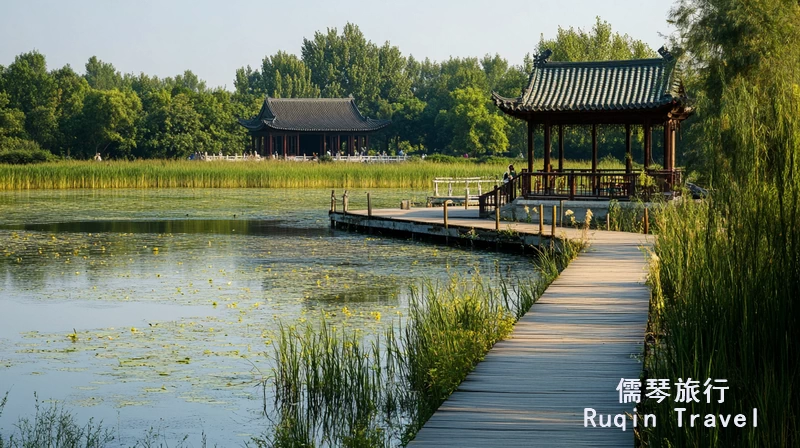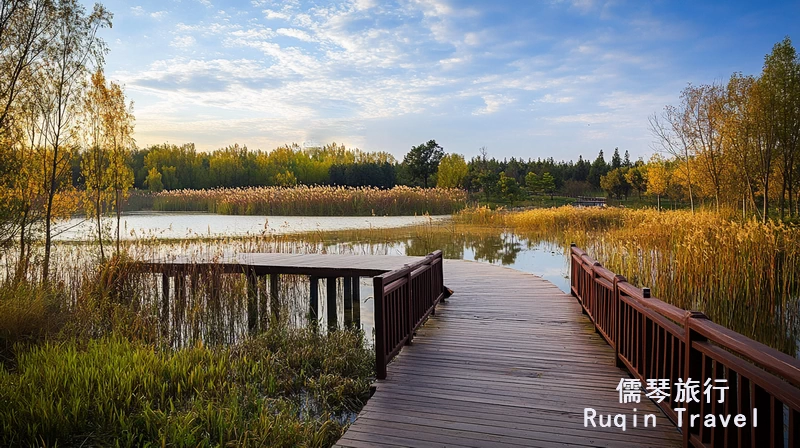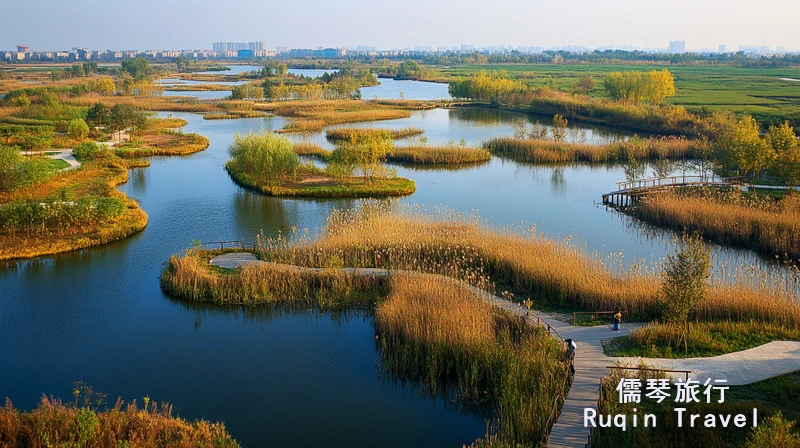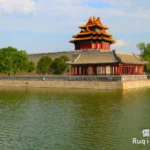Beijing, a bustling metropolis known for its rich history and cultural landmarks, is also home to a variety of stunning wetland parks. These parks offer serene natural landscapes, diverse wildlife, and an escape from the urban hustle, making them perfect destinations for nature lovers and those seeking a tranquil retreat.
This comprehensive travel guide will introduce you to the top wetland parks in Beijing, providing brief introductions to each park along with detailed instructions on how to get there.
1. Hanshiqiao Wetland Nature Reserve 汉石桥湿地公园
Introduction: Hanshiqiao Wetland Nature Reserve, located in Shunyi District, is one of the most important wetland conservation areas in Beijing. Covering an area of 1,900 hectares, the reserve is home to a wide variety of bird species, including several that are protected under Chinese law.

The wetland is composed of reed marshes, lakes, and rivers, creating a rich and diverse ecosystem. The reserve’s primary focus is on conservation, but it also offers opportunities for eco-tourism and environmental education. Visitors can explore the reserve’s walking trails and observation platforms, which provide excellent views of the wetlands and the wildlife that inhabits them.
How to Get There: To reach Hanshiqiao Wetland Nature Reserve, take Line 15 of the Beijing Subway to Fengbo Station. From there, a short taxi ride will bring you to the reserve. The journey offers a peaceful transition from the urban environment of Beijing to the natural beauty of one of the city’s most important wetland areas.
2. Nanhaizi Wetland Park 南海子湿地公园
Introduction: Nanhaizi Wetland Park, situated in Yinhai Town, Daxing District, is Beijing’s largest wetland park. Spanning over 11 square kilometers, it is equivalent in size to four Summer Palaces. Nanhaizi is one of Beijing’s four major suburban parks and has a deep historical significance, as it was once the royal hunting ground during the Ming and Qing dynasties.
Today, the park features vast green spaces, lakes, and walking paths, making it a perfect spot for picnics, bird watching, and leisurely strolls. Its expansive wetlands play a crucial role in supporting local wildlife and maintaining the ecological balance of the area.
How to Get There: Nanhaizi Wetland Park is easily accessible via the Beijing Subway’s Yizhuang Line. Simply take the subway to Nanhaizi Station, and from there, it’s a short walk to the park’s entrance. The ease of access makes it a popular choice for both locals and tourists.
3. Grand Canal Forest Park 大运河森林公园
Introduction: Grand Canal Forest Park is located on both sides of the North Canal in Tongzhou New City and is the only canal ecological oxygen bar in Beijing. The park is a masterpiece of modern landscape architecture, combining contemporary design with natural elements. It features “one river, two banks, six scenic areas, and eighteen scenic spots,” all of which showcase the unique canal culture and Beijing’s natural beauty.
Visitors can enjoy leisurely boat rides, explore the well-maintained walking trails, or simply relax in the park’s lush green spaces. The park’s blend of urban and rural charm makes it a unique destination for those looking to experience a different side of Beijing.
How to Get There: To visit Grand Canal Forest Park, take the Beijing Subway Batong Line to Liyuan Station. From there, you can take a short bus or taxi ride to the park. The journey offers a scenic introduction to Tongzhou District and the park’s beautiful canal-side setting.
4. Yeyahu Wetland Park 野鸭湖市级湿地自然保护区
Introduction: Yeyahu Wetland Park, also known as Wild Duck Lake Wetland, is situated in Yanqing District. This park is particularly popular among bird watchers, as it is one of Beijing’s prime locations for observing migratory birds. Covering an area of approximately 6,873 hectares, Yeyahu is one of the largest wetland reserves in the city and features a diverse array of ecosystems, including marshes, lakes, and grasslands.

The park is named after the wild ducks that are commonly seen here, and visitors can also spot other wildlife such as swans, cranes, and various fish species. Yeyahu’s well-maintained trails and observation platforms make it easy for visitors to explore the park’s natural beauty and observe its rich biodiversity.
How to Get There: To reach Yeyahu Wetland Park, take the Beijing Subway’s Line 13 to Xierqi Station, then transfer to a bus heading towards Yanqing District. From Yanqing, a short taxi ride will bring you to the park. This journey offers a scenic drive through Beijing’s northern suburbs, with the park providing a tranquil escape from the city.
5. Cuihu National Urban Wetland Park 翠湖国家城市湿地公园
Introduction: Cuihu National Urban Wetland Park is located in Haidian District and is one of Beijing’s most accessible wetland parks. It covers an area of about 157 hectares and serves as a vital green space within the city.
The park features a variety of ecosystems, including lakes, marshes, and forests, making it a popular destination for locals looking to enjoy nature without leaving the city. Cuihu is particularly known for its well-maintained walking and cycling paths, which allow visitors to explore the park’s diverse landscapes at their own pace. The park also plays a significant role in environmental education, offering various programs and exhibits that highlight the importance of wetland conservation.
How to Get There: Cuihu National Urban Wetland Park is easily accessible by public transport. You can take Line 16 of the Beijing Subway to Xibeiwang Station, and from there, it’s a short walk to the park entrance. The park’s convenient location makes it an ideal spot for a quick nature retreat within the city.
6. Fangshan Changguo Spring National Wetland Park
房山长沟泉水国家湿地公园
Introduction: Fangshan Changguo Spring National Wetland Park is located in Fangshan District, an area known for its rich natural landscapes and historical sites. The park covers an area of approximately 243 hectares and is famous for its clear spring waters and lush vegetation.
The park’s wetlands are fed by underground springs, which create a series of beautiful ponds and streams that flow through the area. Fangshan Changguo Spring is a great destination for those looking to experience Beijing’s natural beauty and enjoy outdoor activities such as hiking, bird watching, and picnicking. The park’s scenic trails and tranquil atmosphere make it a perfect escape from the hustle and bustle of the city.
How to Get There: To visit Fangshan Changguo Spring National Wetland Park, take the Beijing Subway’s Fangshan Line to Liangxiang University Town Station. From there, a short taxi ride will bring you to the park. The journey offers a chance to explore Fangshan District, known for its scenic landscapes and cultural heritage.
7. Olympic Forest Park 奥林匹克森林公园
Introduction: Located in Chaoyang District, the Olympic Forest Park was constructed for the 2008 Beijing Olympics. It is one of the largest urban green spaces in Beijing, covering an area of 680 hectares. Although not exclusively a wetland park, it features several wetland areas that are home to various bird species and other wildlife.
The park is divided into two sections: the South Garden, which is more formal and landscaped, and the North Garden, which retains a more natural, forested character. The wetland areas are particularly beautiful in the early morning or at sunset when the light reflects off the water, creating a peaceful ambiance.
How to Get There: The Olympic Forest Park is easily accessible by subway. Take Line 8 of the Beijing Subway to Forest Park South Gate Station. The park is right outside the station, making it one of the most convenient green spaces to visit in Beijing.
8. Mentougou Yanchi Jiuhong Wetland Park 门头沟雁翅九河湿地公园
Introduction: Mentougou Yanchi Jiuhong Wetland Park is located in the western suburbs of Beijing, in the mountainous Mentougou District. This park is known for its pristine natural environment, featuring wetlands surrounded by mountains and forests.
The area is particularly famous for its clean air and clear water, making it a popular destination for eco-tourism. The park offers a range of outdoor activities, including hiking, bird watching, and fishing. Its secluded location and unspoiled nature make it a hidden gem for those looking to escape the city and reconnect with nature.
How to Get There: To reach Mentougou Yanchi Jiuhong Wetland Park, take the Beijing Subway Line 1 to Pingguoyuan Station, then transfer to a local bus or taxi heading towards Mentougou District. The journey takes you through some of Beijing’s most scenic mountain landscapes, culminating in a visit to one of the city’s most peaceful wetland parks.
9. Cuijiayao Wetland Park 崔家窑湿地公园
Introduction: Cuijiayao Wetland Park is located in the southeastern part of Beijing, in Tongzhou District. This park is relatively small compared to others on this list, but it offers a unique blend of urban and natural elements. The park is centered around a series of small lakes and ponds, which are connected by walking paths and bridges.
The wetlands are home to a variety of bird species, making it a popular spot for bird watching. Cuijiayao is a great place for a leisurely stroll, offering visitors a peaceful retreat within the city limits. The park’s proximity to the Grand Canal adds to its charm, providing scenic views and a sense of connection to Beijing’s rich history.
How to Get There: To visit Cuijiayao Wetland Park, take Line 6 of the Beijing Subway to Tongzhou Beiyuan Station. From there, it’s a short bus or taxi ride to the park. The park’s location in Tongzhou District makes it an easily accessible green space for those staying in the eastern part of Beijing.
10. Xihai Wetland Park 西海湿地公园
Xihai Wetland Park is located in Xihai, Shichahai, west of Deshengmen in Beijing. The park is surrounded by several historical sites, including Huitong Temple, Sanguan Temple, Jingye Temple, Pujie Temple, and the Deshengmen Arrow Tower.
Xihai Wetland Park covers an area of 10.9 hectares, with 7.4 hectares of water area and 3.5 hectares of surrounding green space. A walking path has been built around the lake, stretching 1,450 meters in length. Additionally, a floating bridge over 50 meters long connects the northern and western banks of Xihai. This bridge not only links the entire Shichahai loop trail but also provides a scenic viewing platform for the wetland park.
The park features approximately 20,000 square meters of aquatic planting areas, including sections for lotus plants, calamus, and reeds. It also has three ecological floating islands that create diverse aquatic plant communities and habitats for various bird species.
Opening Hours: Open all day
Address: No. 60A, Deshengmen West Street, Xicheng District, Beijing
Take Line 2 (Beijing Subway) to Jishuitan Station. Exit the station from Exit C. From Jishuitan Station, you can either take a short taxi ride (approximately 5-10 minutes) to the park or walk, which will take about 15-20 minutes.
Final Thoughts
Beijing’s wetland parks offer a diverse range of experiences, from the tranquil reed marshes of Hanheqiang to the vibrant bird-watching opportunities at Yeyahu. Whether you’re looking for a quick escape within the city limits or a more secluded nature retreat in the suburbs, these parks provide the perfect setting to explore Beijing’s natural beauty. Each park has its unique charm, and together they form a vital part of the city’s ecological landscape, contributing to biodiversity and offering residents and tourists alike a chance to connect with nature.
When planning your visit, consider the accessibility of each park, the types of activities you enjoy, and the time you have available. Whether you choose to visit just one or explore several, Beijing’s wetland parks are sure to leave you with lasting memories of their beauty and tranquility.



